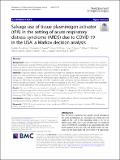| dc.contributor.author | Choudhury, Rashikh | |
| dc.contributor.author | Barrett, Christopher D. | |
| dc.contributor.author | Moore, Hunter B. | |
| dc.contributor.author | Moore, Ernest E. | |
| dc.contributor.author | McIntyre, Robert C. | |
| dc.contributor.author | Moore, Peter K. | |
| dc.contributor.author | Talmor, Daniel S. | |
| dc.contributor.author | Nydam, Trevor L. | |
| dc.contributor.author | Yaffe, Michael B. | |
| dc.date.accessioned | 2020-04-28T13:46:48Z | |
| dc.date.available | 2020-04-28T13:46:48Z | |
| dc.date.issued | 2020-04-20 | |
| dc.identifier.issn | 1749-7922 | |
| dc.identifier.uri | https://hdl.handle.net/1721.1/124896 | |
| dc.description.abstract | BACKGROUND: COVID-19 threatens to quickly overwhelm our existing critical care infrastructure in the USA. Systemic tissue plasminogen activator (tPA) has been previously demonstrated to improve PaO2/FiO2 (mmHg) when given to critically ill patients with acute respiratory distress syndrome (ARDS). It is unclear to what extent tPA may impact population-based survival during the current US COVID-19 pandemic. METHODS: A decision analytic Markov state transition model was created to simulate the life critically ill COVID-19 patients as they transitioned to either recovery or death. Two patient groups were simulated (50,000 patients in each group); (1) Patients received tPA immediately upon diagnosis of ARDS and (2) patients received standard therapy for ARDS. Base case critically ill COVID-19 patients were defined as having a refractory PaO2/FiO2 of < 60 mmHg (salvage use criteria). Transition from severe to moderate to mild ARDS, recovery, and death were estimated. Markov model parameters were extracted from existing ARDS/COVID-19 literature.RESULTS: The use of tPA was associated with reduced mortality (47.6% [tTPA] vs. 71.0% [no tPA]) for base case patients. When extrapolated to the projected COVID-19 eligible for salvage use tPA in the USA, peak mortality (deaths/100,000 patients) was reduced for both optimal social distancing (70.5 [tPA] vs. 75.0 [no tPA]) and no social distancing (158.7 [tPA] vs. 168.8 [no tPA]) scenarios. CONCLUSIONS: Salvage use of tPA may improve recovery of ARDS patients, thereby reducing COVID-19-related mortality and ensuring sufficient resources to manage this pandemic. ©2020 | en_US |
| dc.publisher | Springer Science and Business Media LLC | en_US |
| dc.relation.isversionof | 10.1186/s13017-020-00305-4 | en_US |
| dc.rights | Creative Commons Attribution 4.0 International license | en_US |
| dc.rights.uri | https://creativecommons.org/licenses/by/4.0/ | en_US |
| dc.source | BioMed Central (BMC) | en_US |
| dc.subject | Surgery | en_US |
| dc.subject | Emergency Medicine | en_US |
| dc.title | Salvage use of tissue plasminogen activator (tPA) in the setting of acute respiratory distress syndrome (ARDS) due to COVID-19 in the USA: a Markov decision analysis | en_US |
| dc.type | Article | en_US |
| dc.identifier.citation | Choudhury, Rashikh, et al., "Salvage use of tissue plasminogen activator (tPA) in the setting of acute respiratory distress syndrome (ARDS) due to COVID-19 in the USA: a Markov decision analysis." World Journal of Emergency Surgery 15, 1 (Apr. 2020): no. 29 doi 10.1186/s13017-020-00305-4 ©2020 Author(s) | en_US |
| dc.contributor.department | Koch Institute for Integrative Cancer Research at MIT | en_US |
| dc.relation.journal | World Journal of Emergency Surgery | en_US |
| dc.eprint.version | Final published version | en_US |
| dc.type.uri | http://purl.org/eprint/type/JournalArticle | en_US |
| eprint.status | http://purl.org/eprint/status/PeerReviewed | en_US |
| dspace.date.submission | 2020-04-24T16:58:55Z | |
| mit.journal.volume | 15 | en_US |
| mit.journal.issue | 1 | en_US |
| mit.license | PUBLISHER_CC | |
| mit.metadata.status | Complete | |
